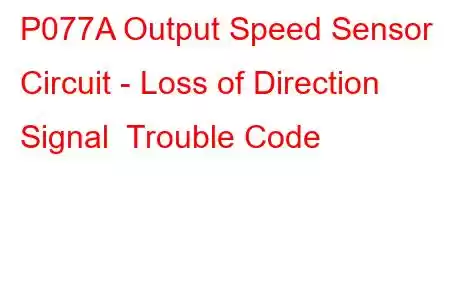P077A Output Speed Sensor Circuit - Loss Of Direction Signal
OBD-II Trouble Code Technical Description
Output Speed Sensor Circuit - Loss Of Direction Signal
What does that mean?
This generic powertrain diagnostic trouble code (DTC) typically applies to many OBD-II vehicles. That may include but is not limited to vehicles from Chevrolet, Ford, Toyota, Dodge, Honda, etc.
When your vehicle has stored a code P077A, it means that the powertrain control module (PCM) has detected a loss of directional signal from the output speed sensor.
Output speed sensors are typically of the electromagnetic variety. They utilize some type of toothed reluctor ring or gear that is permanently affixed to the transmission output shaft. As the output shaft spins, so spins the reluctor ring. The raised teeth of the reluctor ring complete the output speed sensor circuit when they pass in close proximity to the stationary electromagnetic sensor. As the reluctor passes by the electromagnetic tip of the sensor, the notches between the reluctor ring teeth create interruptions in the sensor circuit. This combination of circuit completions and interruptions are received by the PCM (and other controllers) as wave form patterns which represent transmission output speed.
The sensor either threads directly into the transmission housing or is held in place with a bolt. An O-ring seal is used to prevent fluid leaking from the sensor opening.
The PCM compares transmission input speed and output speed to determine if the transmission is shifting correctly and operating efficiently.
If a code P077A is stored, the PCM has detected an input voltage signal from the output speed sensor indicating that the reluctor ring is not moving. When the output speed sensor voltage signal fails to fluctuate, the PCM assumes that the reluctor ring has unexpectedly stopped moving. The PCM receives vehicle speed input data and wheel speed input data in addition to the output speed sensor data. By comparing these signals, the PCM can determine if the reluctor ring is moving sufficiently (according to the output speed sensor signal). An immobile output speed sensor signal may be caused by either an electrical malfunction or a mechanical problem.
Here is an example of a transmission speed sensor:
What is the severity of this DTC?
The conditions which contribute to a code P077A being stored could result in (or be the result of) catastrophic transmission failure, it should be rectified with urgency.
What are some of the symptoms of the code?
Symptoms of a P077A engine code may include:
Intermittent speedometer/odometer operation Abnormal transmission shift patterns Transmission slippage or delayed engagement Activation/deactivation of the traction control system (if applicable) Other transmission and/or ABS codes may be storedWhat are some of the common causes of the code?
Causes for this code may include:
Defective output speed sensor Metal debris on the output speed sensor Open or shorted circuits or connectors (especially near the output speed sensor) Damaged or worn reluctor ring Mechanical transmission failureWhat are some P077A troubleshooting steps?
I typically like to begin my diagnosis of a P077A with a visual inspection of system wiring and connectors. I would remove the output speed sensor and clean excessive metallic debris from the magnetic tip. Use caution when removing the sensor because hot transmission fluid may leak from the sensor opening. Repair open or shorted circuits and connectors as required.
Check the reluctor ring when the sensor is removed for inspection. If the reluctor ring is damaged, cracked, or if any teeth are missing (or worn), you have most likely found your problem.
Check automatic transmission fluid if other transmission related symptoms are exhibited. Fluid should appe
Read: 28


